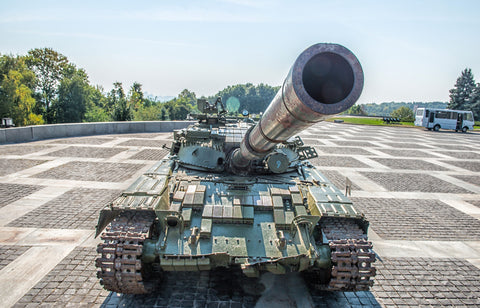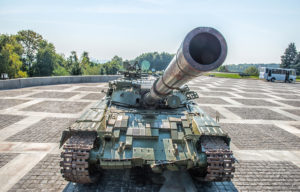
T-64 Tank: The Soviet Weapon Ukraine Has Turned Against Russia

It’s a weapon that Ukraine used to make for Russian soldiers. But now Ukraine’s turned the T-64 tank against its erstwhile comrades — and proving that this Cold War tank still has some fight left in it.
The Soviet origin of the t-64
When the Soviet Union broke up in 1991, it left three tank building establishments in operation. Two, in the Russian Federation, were at Leningrad (now St. Petersburg), maintaining production of the T-80, and Nizhni-Tagil, primary producer of the relatively simple and inexpensive T-72 and its Russian-designed successor, the T-90. The remaining factory, in the Ukrainian city of Kharkiv, Ukraine, produced the most innovative and problematic tank of the late 20th century: the T-64.
The T-64’s chief designer, Aleksandr Morozov, had previously gained fame for two outstandingly simple but effective tanks, the T-34 and the T-54. The T-64, in contrast, sought to gain qualitative superiority on the battlefield with unprecedented inventiveness, such as a compact engine arrangement and an auto-loader for its 125 mm smoothbore cannon, which could fire shells or antitank missiles. They added up to produce a tank weighing a mere 38 tons and carrying a three-man crew, capable (in theory) of taking on the standard four-man main battle tanks of its Western opposition. When it entered service in 1964, the T-64 was used exclusively by Soviet tank regiments, and its technical details were veiled in secrecy for many years.
Also kept secret for as long as possible was the embarrassing frequency with which its technological innovations malfunctioned in the field, including a tendency of the autoloader to “eat” the left arms of insufficiently attentive gunners. The relatively modest 13,000 T-64s built between 1964 to 1987 reflected the tanks’ difficulties and its expense — 40 percent more than the simpler T-72 that was developed to supplement and ultimately eclipse it in Soviet use, as well as dominate international sales.
GET HISTORY’S GREATEST TALES—RIGHT IN YOUR INBOX
Subscribe to our Historynet Now! newsletter for the best of the past, delivered every Wednesday.
Becoming a Post-Communist tank
When the postwar Soviet Union transitioned from a single Communist empire to a diverse collection of independent states, it left them all economically challenged — but their militaries well-stocked with weaponry. In Ukraine’s case, its arsenal included the majority of T-64s produced and a still-active factory. As relations with Russia became strained, the Ukrainians strove to make do by upgrading the armor they had on hand.
In addition to the aging T-64BV, the Ukrainians improved the basic design with the T-62BM Bulat, which featured an 850-horsepower 5TDFM diesel engine capable of attaining a maximum speed of 70 kilometers per hour (43 miles per hour) and a range of 385 kilometers (239 miles). This increase in power compensated for improvements that added up to 45 tons.
Its 125 mm 9K119Svir (NATO designation AT-11 Sniper) cannon fires a variety of shells or missiles and features an improved autoloader, although its fire control system is reportedly inferior to its predecessor’s. It can fire its shells to a range of 2,500 meters (8,200 feet) by day and 1,500 meters (4,920 feet) by night. The main armament is supplemented by a 7.62 mm coaxial machine gun and a 12.7 mm anti-aircraft machine gun.
The tank is protected by add-on passive and explosive reactive armor, as well as composite armor in the front of both the hull and the turret. A wading kit allows the tank to ford streams up to five meters deep.
Recommended for you
WHO USES T-64S?
Upon gaining independence, Ukraine had about 2,000 T-64s, 1,000 T-72s and 300 T-80s. Russia also had some T-64s, as did Uzbekistan, in addition to which 25 found their way to the Democratic Republic of the Congo.
The first upgraded T-64BM Bulats were revealed in 1999, entered Ukrainian service in 2005 and entered combat in 2014, when the Russians began supporting insurgents in the eastern Ukraine. Ukraine had 720 T-64BVs and T-64BMs operational at that time, with another 600 in reserve. A significant number of Ukrainian tanks reportedly fell victim to insurgents armed with antitank infantry weapons, showing that they were just as vulnerable to those weapons as were their Russian counterparts.
ukrainian t-64 versus russian t-64
When Russia launched its 2022 invasion, Ukraine, though outnumbered overall, committed all its available tanks toward engaging and later driving back the Russian army. The T-64BVs made up the bulk of their offensive armor, although the Russians used some of their own smaller stocks of the elderly but still deadly vehicles. As of April 29, the Ukrainians had lost 110 T-64BVs and on April 25 the Russians reported knocking out their first T-64BM. The Russians, in turn, lost 16 of their own T-64BVs during the same period.
As of mid-May 2022, counterattacking Ukrainian force drove the Russians back from Kharkiv. Undoubtedly T-64s built there were in the vanguard of that effort. It is equally likely that Ukraine’s inherited, improved tanks will be turning up in further operations to come.
historynet magazines
Our 9 best-selling history titles feature in-depth storytelling and iconic imagery to engage and inform on the people, the wars, and the events that shaped America and the world. Sale! Save $7.99 on your subscription today!









